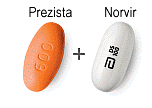Once-daily
Boosted Darunavir (Prezista) Works as Well as Twice-daily for Treatment-experienced
Patients
 |
 |
 |
 |
 |
 |
 |
| SUMMARY:
Taking ritonavir-boosted
darunavir (Prezista) once instead of twice per day leads
to equally good virological suppression in previously treated
individuals, according to a presentation at the 17th Conference
on Retroviruses & Opportunistic Infections (CROI
2010) last week in San Francisco. The once-daily regimen
was associated with fewer side effects and did not lead to
development of drug-resistance mutations. |
|
 |
 |
 |
 |
 |
 |
 |
By
Liz Highleyman
 Pedro
Cahn presented findings from the ODIN Trial (TMC114-C229), a Phase 3b
open-label study comparing the efficacy, safety, and tolerability of
once-daily versus twice-daily boosted darunavir in treatment-experienced
patients. Once-daily darunavir/ritonavir is currently approved for first-line
therapy, but not for previously treated individuals.
Pedro
Cahn presented findings from the ODIN Trial (TMC114-C229), a Phase 3b
open-label study comparing the efficacy, safety, and tolerability of
once-daily versus twice-daily boosted darunavir in treatment-experienced
patients. Once-daily darunavir/ritonavir is currently approved for first-line
therapy, but not for previously treated individuals.
The study included 590 participants. A majority (64%) were men and the
mean age was 40 years. All had detectable viral load (mean of approximately
15,000 copies/mL), a CD4 cell count > 50 cells/mm3 (median 228 cells/mm3),
and no pre-existing darunavir resistance-associated mutations. They
were stratified according to whether their viral load was above or below
50,000 copies/mL.
Participants had been on a stable combination
antiretroviral therapy (ART) regimen for at least 12 weeks at the
time of screening. Overall, 46% had never been exposed to protease
inhibitor and 13% had not used non-nucleoside
reverse transcriptase inhibitors (NNRTIs). More than half (60%)
had at least 2 other active drugs in their background regimen.
Participants were randomly assigned (1:1) to receive either darunavir/ritonavir
800/100 mg once-daily or darunavir/ritonavir 600/100 mg twice-daily
for 48 weeks, along with an optimized nucleoside/nucleotide
reverse transcriptase inhibitor (NRTI) backbone. Baseline characteristics
were similar in the 2 treatment arms.
Unlike
some drugs, the once-daily darunavir/ritonavir dose does not simply
double the twice-daily dose and take it all at once, but rather allows
patients to use a considerably lower total amount per day.
The study
was designed to establish non-inferiority of the once-daily regimen
with a margin of 12%.
Results
 |
At
week 48, similar proportions of patients in the once-daily darunavir/ritonavir
arm (72.1%) and the twice-daily arm (70.9%) achieved HIV RNA <
50 copies/mL. |
 |
The
difference in response was 1.2%, falling comfortably within the
12% margin and thus establishing non-inferiority (P < 0.001). |
 |
Within
the low baseline viral load group, the respective virological response
rates were 78.4% in the once-daily arm vs 76.8% in the twice-daily
arm. |
 |
Among
those with high baseline viral load, the response rate was 52.8%
in both arms. |
 |
There
were 65 instances of virological failure in the once-daily arm (22.1%)
compared with 54 (18.2%) in the twice-daily arm. |
 |
Median
CD4 cell gains were 100 cells/mm3 in the once-daily arm and 94 cells/mm3
in the twice-daily arm, not a significant difference. |
 |
10
people (3.4%) in the once-daily arm and 14 (4.7%) in the twice-daily
arm discontinued the study due to adverse events. |
 |
Moderate-to-severe
adverse events were about half as frequent in the once-daily arm
(7.8%) compared with the twice-daily arm (15.2%). |
 |
This
difference was largely due to differences in lipid abnormalities,
as grade 2-4 lipid changes were about half as common. |
 |
Only
1 individual developed a primary protease inhibitor resistance-associated
mutation, in the once-daily arm. |
"Once-daily [darunavir/ritonavir] 800/100 mg was effective and
non-inferior to [darunavir/ritonavir] 600/100 mg bid over 48 weeks,"
the investigators summarized.
"Virological
failure was low and rarely resulted in resistance," they continued.
"[Darunavir/ritonavir] was generally well tolerated" and there
were "few discontinuations due to adverse events."
"These
findings suggest that once-daily [darunavir/ritonavir] could be considered
an option for patients failing previous treatments with no [darunavir]
resistance-associated mutations."
Fndn
Huesped, Buenos Aires, Argentina; Med Res Council, Tygerberg, South
Africa; Inst de Pesquisa Clin Evandro Chagas-Fiocruz, Rio de Janeiro,
Brazil; Univ of Med and Dentistry of New Jersey, Newark, NJ; Hosp St-Louis,
Paris, France; Thai Red Cross AIDS Res Ctr, Chulalongkorn Univ, Bangkok;
Ground Zero Med Ctr, Darlinghurst, Australia; Tibotec BVBA, Mechelen,
Belgium; Tibotec Inc, Yardley, PA.
2/26/10
Reference
P
Cahn, J Fourie, B Grinsztejn, and others. Efficacy and Safety at 48
Weeks of Once-daily vs Twice-daily DRV/r in Treatment-experienced HIV-1+
Patients with No DRV Resistance-associated Mutations: The ODIN Trial.
17th Conference on Retroviruses & Opportunistic Infections (CROI
2010). San Francisco. February 16-19, 2010. Abstract 57.